 PO
Box 9021, Wilmington, DE 19809, USA
PO
Box 9021, Wilmington, DE 19809, USAE-mail: font@focusonnature.com
Phone: Toll-free in USA 1-888-721-3555
or 302/529-1876
Website: www.focusonnature.com
 PO
Box 9021, Wilmington, DE 19809, USA
PO
Box 9021, Wilmington, DE 19809, USA
E-mail: font@focusonnature.com
Phone: Toll-free in USA 1-888-721-3555
or 302/529-1876
Website: www.focusonnature.com
Cranes
during Focus On
Nature Tours
in Japan
and in
North America
a collection of
notes & photographs
compiled by Armas Hill
Upcoming FONT Birding & Nature Tours
in Japan
Japan
Past FONT Tour Highlights
Upcoming FONT Birding & Nature Tours
in North America
Lists & Photo
Galleries of Birds in:
Japan
North America
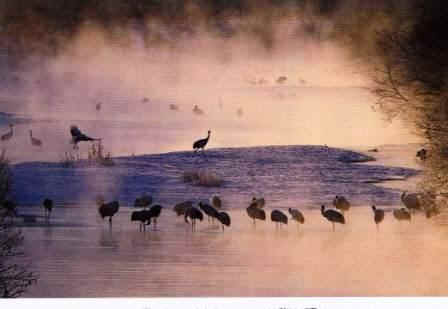
Red-crowned, or Japanese Cranes
in a river at the end of a wintry day
during a FONT tour in Hokkaido, Japan
In the upper right illustration, White-naped Cranes, another species seen
during FONT Japanese tours.
Of the 15 species of cranes in the world, 7 have been seen during FONT winter
tours in Japan.
Included here are photos and information relating to those 7 species: the Red-crowned Crane,
White-naped Crane, Siberian Crane, Hooded Crane, Common Crane, Demoiselle Crane,
and the Sandhill Crane.
Since 1994, there have been 23 FONT tours in Japan during which cranes have been
seen.
2 species of cranes occur in North America, the rarest in the world, the
Whooping Crane, and the most common in the world, the Sandhill Crane.
The Whooping Crane has been seen during FONT tours in Nebraska, and Texas.
The Sandhill Crane has been seen during FONT tours in Alaska, Arizona, British
Columbia, California, Colorado, and Nebraska.
During our autumn tour in Wisconsin, we visit the International Crane
Foundation, a fascinating place and an organization that has done so
much.
Below, some photos and information relating to the two North American cranes follows
what's here relating to cranes in
Japan.
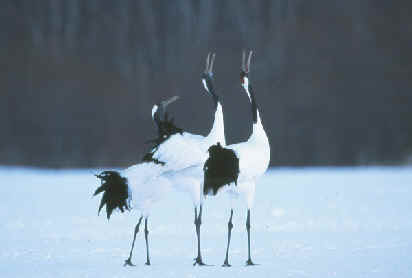
The RED-CROWNED (or JAPANESE) CRANE
(also called, in mainland Asia, the MANCHURIAN CRANE)
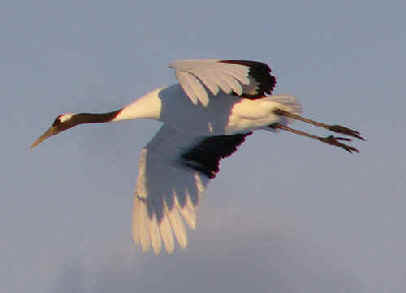
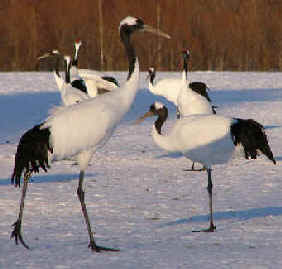
Red-crowned, or Japanese, Cranes in Hokkaido,
Japan
The RED-CROWNED CRANE is the second rarest crane in the world
(after the WHOOPING CRANE of North America).
The total population in the wild
has recently been between about 2,700 birds (about 1,200 in Japan &
approximately 1,500 in eastern mainland Asia) .
There is a resident population of the Red-crowned Crane on Japan's
northern island, Hokkaido. That is the only place in Japan where the species
normally occurs.
At one time, it bred on all 4 of the main Japanese islands, but
it declined dramatically in Japan in the 19th Century.
By 1890, it remained only
in Hokkaido, where it nested (and continued to do so) in marshes in the
southeast part of the island.
In the 1920's, the total Japanese population was
ONLY ABOUT 20 INDIVIDUALS.
Since then, the number in Hokkaido, due to protection
and artificial feeding (in the winter), has increased to over 1,200
birds.
A migratory population of the Red-crowned
Crane on continental Asia (of
about 1,500 birds) breeds in northeast China, eastern Russia, and Mongolia, and
winters in eastern China and Korea. Nesting is in large wetlands. Feeding is in
marshes with relatively deep water. Nests are in areas with standing dead
vegetation. Preferred foraging sites are wet (such as rivers, marshes, and
lakes), but on occasion birds will forage on dikes and in croplands.
One of these Red-crowned Cranes (a "Manchurian
Crane", rather than a "Japanese Crane"), an immature bird, that
would normally winter (as noted above) in eastern China or Korea, was seen on
the southern Japanese island of Kyushu, with wintering White-naped and Hooded
Cranes, during our FONT tour in February 2005. It was the first occurrence of a
Red-crowned Crane there in 37 years!
Watching and listening to a flock of Japanese Cranes, as we do during our
tours in the winter on Hokkaido, in northern Japan, as the birds fly against a blue sky and feed
and dance on a snowy field is one of the world's thrilling natural experiences!
During our tours the spring, we enjoy family groups of these cranes in the marshes, along
with other sights and sounds of that season.
More photographs of Japanese, or Red-crowned, Cranes follow.
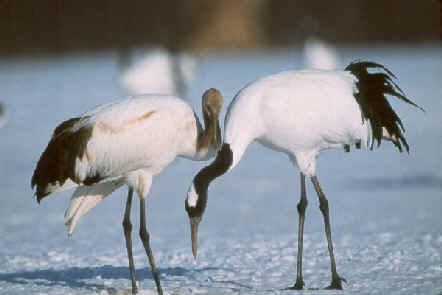
The above photos were
taken
during a FONT Japan tour, in
January 2000,
by Joe Fuhrman, of California, USA.
The following 3 photos taken during the FONT Japan tour in January 2001,
by
Allan Beach, of Ohio, USA.
The final photo taken by Armas Hill, during his first visit to Japan in
1984.
Yearly counts of Japanese
Cranes on the island of Hokkaido in Japan
(a wonderful story):
1952 33
1953 42
1954 52
1955 61
1956 76
1957 92
1958 125
1959 139
1960 172
1961 175
1962 184
1963 147
1964 154
1965 172
1966 170
1967 200
1968 171
1969 212
1970 179
1971 147
1972 222
1973 233
1974 253
1975 194
1976 220
1977 257
1978 214
1979 271
1980 267
1981 295
1982 320 (the year of the
above close-up photo by Armas Hill)
1983 345
1984 327
1985 384
1986 383
1987 424
1988 485
1989 356
1990 441
1991 499
1992 557 (the year of the first
FONT winter birding tour in Japan)
1993 611
1994 628
1995 607
1996 598
1997 586
1998 616
1999 709
2000 519
2001 798
2002 808
2003 908
2004 1,003
2005 1,081
2006 1,013
2007 1,200
2008 1,280
2009 1,324
2010 1,235
2011 1,143
2012 1,163
![]()
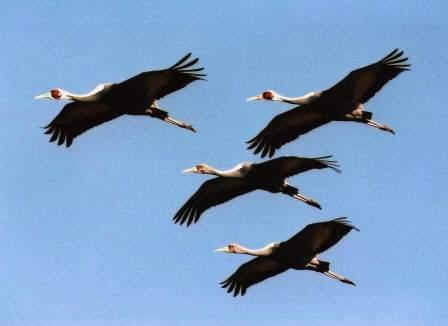
The WHITE-NAPED CRANE
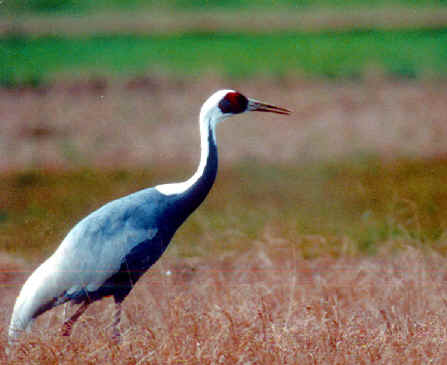
The elegant WHITE-NAPED CRANE breeds, for the
most part, in wetlands in northeastern China, at about 6 localities. Some
(several hundred birds) breed in adjacent Mongolia.
A few (less than 20 pairs)
breed in southeast Russia.
The total population of the species is estimated at
about 5,000 individuals.
Birds from the western portion of the breeding range (approximately 2,000)
migrate south through China, resting in the Yellow River Delta, and then
wintering in the middle Yangtze River
Valley.
Birds from the eastern portion of the breeding range (approximately 2,000)
migrate south through the Korean Peninsula.
Several hundred winter in the
Demilitarized Zone between North and South Korea.
The remainder continue to the
Japanese island of Kyushu, particularly to the area of Arasaki on the west side
of the island.
In the past, the White-naped Crane was more numerous and widely
distributed than it is now.
However, also in the past (but not as long ago),
there were less than there are today. The population was at its lowest after
World War II and the Korean War. Since then, numbers have increased in parts of
the range, and decreased in others.
Arasaki, on Kyushu, Japan, is a very important wintering site for the species.
It is the only Japanese site for the bird.
In 1992, just over 2,000 White-naped
Cranes wintered there, along with over 8,000 Hooded Cranes.
By the year 2000,
there were about 2,500 White-naped Cranes wintering at Arasaki.
The lower of
the two photos above
of
a White-naped Crane was taken during a FONT
Japan tour, in January 1998, by Bill Leaning of Virginia, USA.
Photos that
follow were taken during various FONT tours. The first photo was taken in
February 2005. Trevor Ford of Australia (second photo, left
side), Allan Beach of Ohio, USA in January 2001 (third photo, right side), and by Bill Leaning
in 1998 (fourth photo).
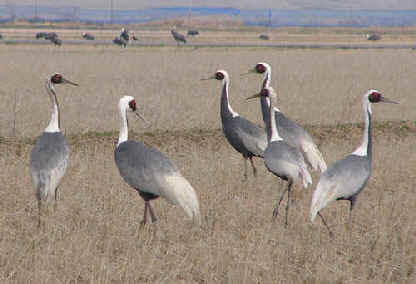
![]()
SIBERIAN CRANE
The SIBERIAN CRANE, a large white bird, with black on its
wings, is the third rarest crane in the world (after the WHOOPING and
RED-CROWNED CRANES).
Until 1981, it was thought to be even more rare and
endangered. During that year, about 800 birds were discovered wintering at Lake
Poyang, China's largest freshwater lake, along the Yangtze River.
With that, the
known population nearly doubled. Subsequent field surveys showed the total
population of the species to be about 3,000 birds.
But still the outlook for the species certainly continues to be precarious.
According to the crane specialist, George Archibald, "from the tundra to
the subtropics, few endangered species involve so many complex problems in so
many countries as does the Siberian Crane". So, the apt classification of
the species as "endangered".
There are 3 populations of Siberian Cranes. All
but a few of the 3,000 birds belong to the eastern population, which breeds in
northeastern Siberia, and winters along the Yangtze River in China.
Another very small central population has bred in the lower basin of the Konovat
River in western Siberia, and has wintered in the Indian state of Rajasthan
(most regularly in the Keoladero National Park). When this population was
observed at its wintering grounds in 1992-93, it included just 5
birds. Only 4
birds were observed in the Kunovat breeding grounds in 1995.
The western population (also very small and threatened), which apparently held
at 8 to 14 birds in the late 1980's and early 1990's, has wintered at a single
site along the southern coast of the Caspian Sea in Iran. The exact location of
the breeding grounds of that population is unknown, but it's thought to be in
the extreme northern portion of European Russia.
Thus, two populations of this species are extremely vulnerable (on the verge of
extinction).
These populations have declined from just over a hundred birds in
the 1960's (when they were discovered).
The Siberian Crane has occurred as a vagrant in Japan in recent years, most
often recently with the White-naped and Hooded Cranes from mainland Asia that
winter on Kyushu.
Those in Japan are wanderers, on occasion, from the larger
eastern population of the species that normally winters in China.
Actually, in the past, the Siberian Crane was a common winter visitor in Japan
on Kyushu prior to the Mejii Era.
Throughout the 20th Century, it became
accidental, but there were some occurrences from Hokkaido south to Okinawa.
Mostly, however, on Kyushu, but some on Hokkaido: in Oct-Dec 1977 and in
May-Sep 1985. The latter was a summering bird in the Kushiro district, where the
Japanese population of the Red-crowned Crane occurs.
Where Siberian Cranes breed in Asia, huge distances separate nesting pairs.
Within each 1000 square kilometers in the breeding range, there are only 1 or 2
pairs of cranes.
The Siberian is the most aquatic of cranes, exclusively using wetlands for
nesting, feeding, and roosting. The nests are in bogs and marshes. In migration
and in wintering areas, the bird prefers to feed and roost in shallow wetlands,
even artificial water impoundments. Its preferred foods are roots, sprouts, and
stems of sedges and other aquatic plants.
Siberian Cranes do not occur in Japan every year, but individuals have been seen during 5 FONT tours in Kyushu in the winter.
Photos follow of Siberian Cranes during FONT tours in Kyushu, Japan. The first was photographed in 2000 by Trevor Ford of Australia, the second in 2001 by Allan Beach of Ohio, USA. Another photograph follows of a Siberian with White-naped Cranes, by Trevor Ford.
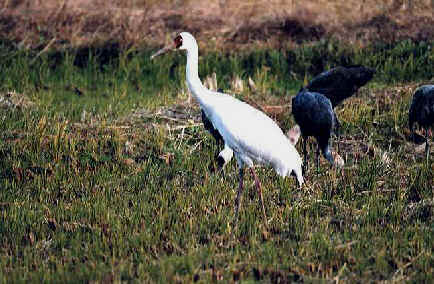
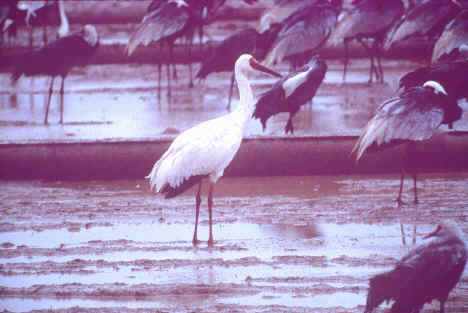
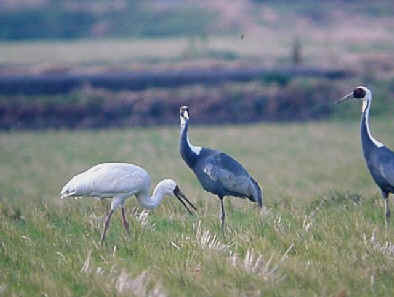
A Siberian Crane with White-naped Cranes in Japan during a FONT tour
And, below, yet a couple more photographs of Siberian Cranes in Japan
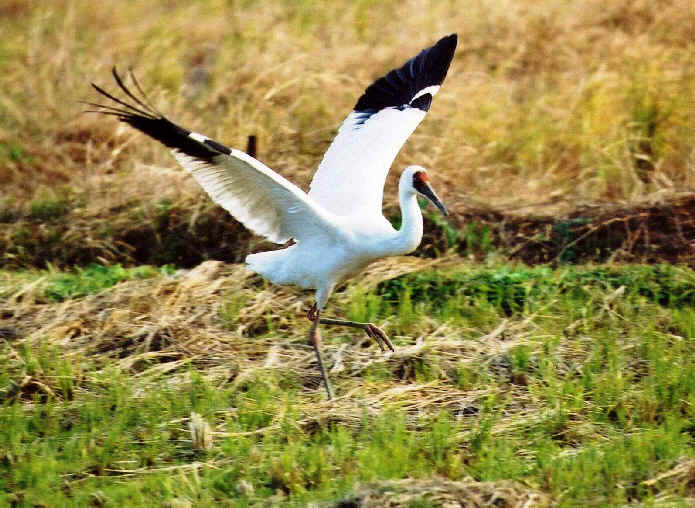
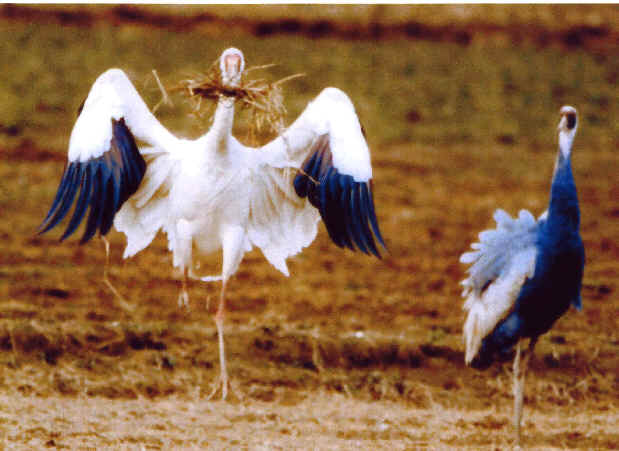
Here a Siberian Crane with a White-naped Crane
![]()
HOODED CRANE
The HOODED CRANE breeds in wetlands in two
areas of central Siberia.
A very few have been known to breed in China since
1991.
Nesting occurs in isolated, widely scattered bogs in the tiaga and other
forested wetlands - preferring mossy areas with a few larch trees, and avoiding
areas either too open or too densely forested.
The Hooded Crane winters at a few localities in Japan, Korea, and eastern China.
The total population has been estimated, during recent years, from about
10,000
to 11,800 birds, having increased due to artificial feeding (particularly at one
prime wintering site, at Arasaki, in Kyushu, Japan).
At Arasaki, more than 80
per cent of the world's Hooded Cranes spend the winter. In that area in 1992,
there were nearly 9,000 birds.
The species winters at only one other place in
Japan: at Yashiro on Honshu, with about 100 birds there.
In Japan and Korea, the Hooded Crane winters almost exclusively at feeding
stations and in agricultural fields.
In China, they tend to roost along the
shores of rivers and shallow lakes, and to forage along the muddy edges of lakes
and nearby grasslands and rice paddies.
The population of Hooded Cranes has fluctuated considerably since the 1920's,
but at present, the number is probably as large as at any point since then.
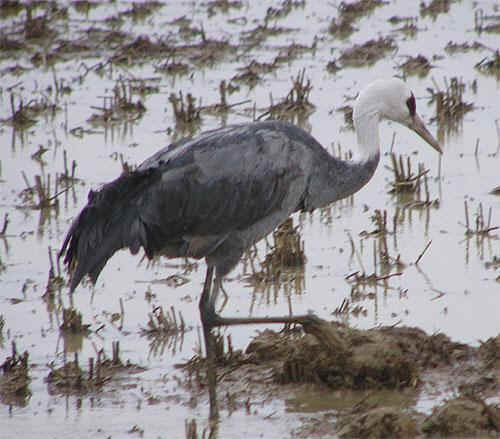
A single Hooded Crane walking
in wet field
on the southern Japanese island of Kyushu,
(photographed during a FONT tour)
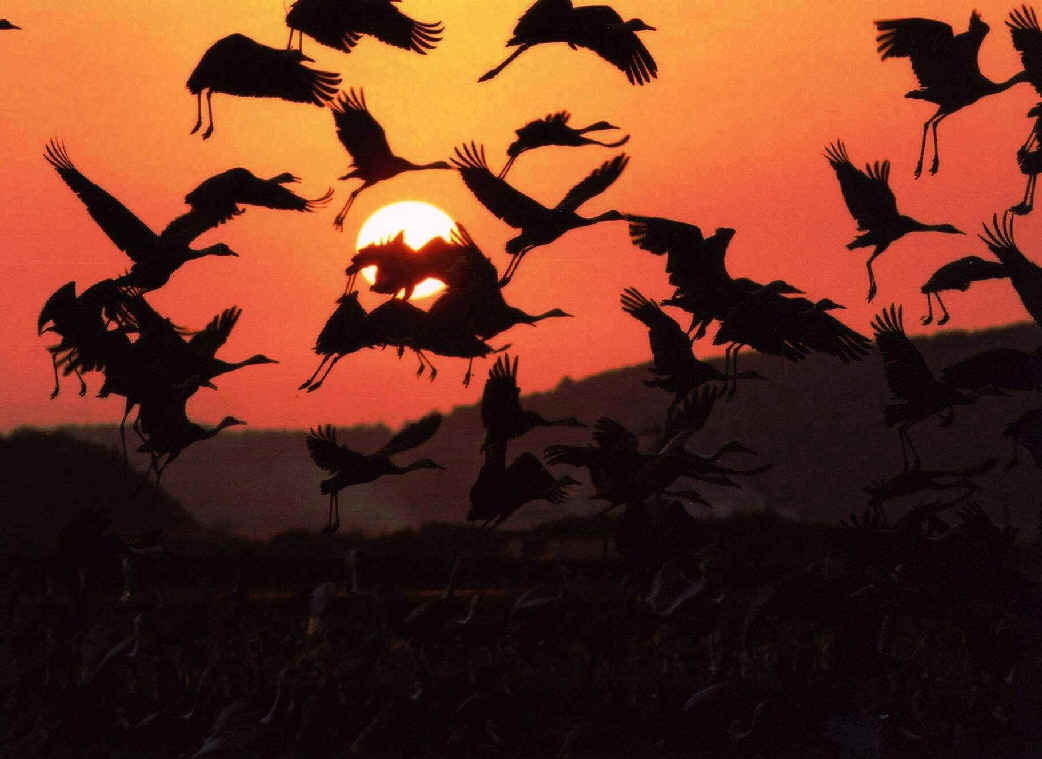
Hooded Cranes at dawn.
Japan is the "Land of the Rising Sun".
Here, the cranes were also rising early one morning
during a FONT tour on Kyushu, Japan.
Hooded Cranes are in more photographs
below. In the photo below that of the single Common Crane, there are Hooded
Cranes with White-naped Cranes and a Sandhill Crane. That photo was
taken by Trevor Ford of Australia.
And below that in the following photograph, there are Hooded and White-naped
Cranes. That photograph was
taken by Bill Leaning of Virginia, USA, during a FONT tour in January 1998.
![]()
SANDHILL & COMMON CRANES
The Common
Crane, which occurs across
Eurasia, is also an annual visitor to Arasaki, on Kyushu, Japan, with 1 or 2
birds each winter, and with maybe a hydrid or two (between Common &
Hooded).
The SANDHILL, the most common North American crane, does breed as well
in eastern Siberia.
A very few SANDHILL CRANES
occur at
Arasaki, on Kyushu, Japan, every winter, among the HOODED and WHITE-NAPED
CRANES.
COMMON and SANDHILL CRANES have been seen during all FONT winter tours on
Kyushu in Japan.
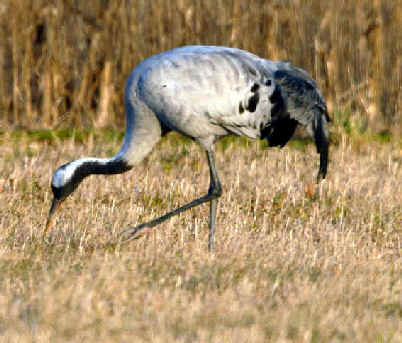
A Common Crane
(photo by Howard Eskin)
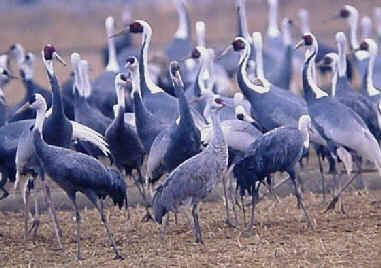
In this photo, White-naped, Hooded, and a Sandhill Crane
during a FONT tour in Kyushu, Japan
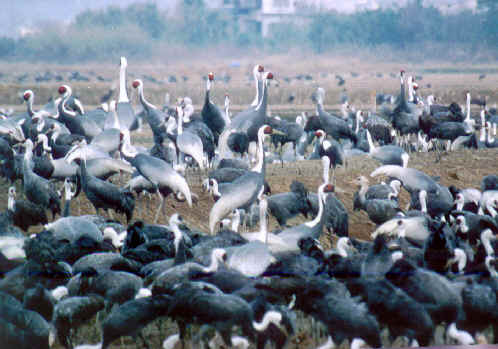
In this photo, a mass of Hooded & White-naped Cranes in Kyushu, Japan
No where else in the world are there so many of these species.
![]()
DEMOISELLE CRANE
The DEMOISELLE CRANE is a rare visitor to
Japan. It is the seventh of the cranes in Japan presented here.
Most Demoiselle Cranes in Japan have been individuals wintering with the crane
flocks, of Hooded and White-naped, on Kyushu.
But there have been a few instances elsewhere in Japan, including one bird on
Hokkaido in May and June 1974 (in the Kushiro district, where the Japanese
population of the Red-crowned Crane occurs).
During one FONT winter tour on Kyushu, 3 Demoiselle Cranes were seen. During
another tour (in February 2005), one was seen.
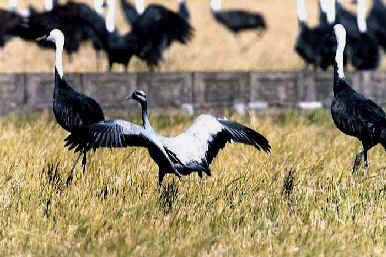
A photograph of
a Demoiselle Crane, with Hooded Cranes,
during a FONT
Japan Winter Birding Tour
(photo by
Trevor Ford of Australia)
![]()
Regarding the
Whooping Crane and the Sandhill Crane,
seen during FONT tours in North America:
WHOOPING
CRANE
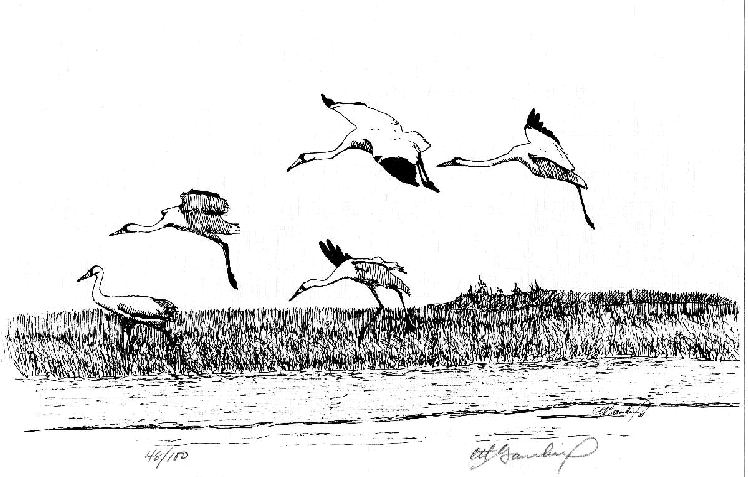
Above: A Drawing of Whooping Cranes
at the Aransas Refuge in Texas,
given as a gift to Armas Hill from the illustrator, Charles Gambill
Below, a family of Whooping Cranes at the Aransas Refuge,
a young bird flanked by its two parents.
(photo by Marc Felber)
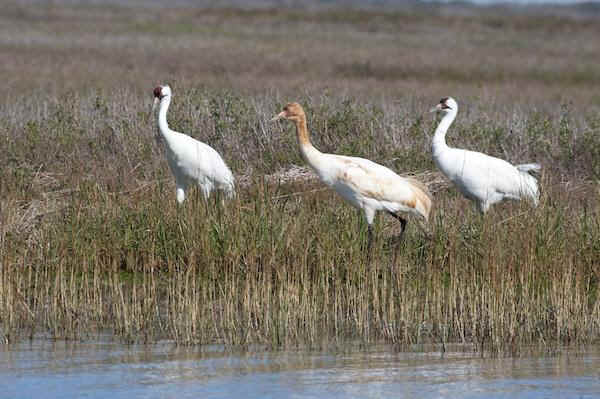
WHOOPING CRANES were
seen during the FONT tour in Texas in March 2014.
In North
America, the WHOOPING CRANE is the rarest crane in the world, although not as
rare as it once was.
Since the birds reached their low point in 1941, with only 15 recorded in Texas
after the disappearance of those that had wintered nearby on the immense King
Ranch, the wildlife services of the United States and Canada, working together,
have brought about an amazing comeback.
2011 was a good year for the Whooping Crane, particularly so in relation to the
long-established population that breeds in the Northwest Territories of Canada
and winters in the Aransas area of coastal Texas.
In August of 2011, a record of 37 Whooping Crane chicks fledged from 75 nests in
the Wood Buffalo National Park in Canada.
12 juvenile Whooping Cranes were captured there in August, bringing the total
number of radioed birds to 23.
That, itself, is more than what the total Whooping Crane population was back
in
the 1940s, when only from 14 to 20 birds were dutifully reported as the number
known to exist then by the Chicago Tribune.
The size of the 2010-2011 winter flock at Aransas was 283 birds.
During the winter prior to that, 2009-2010, there were 263 birds.
In 2008-2009, there were 270. In 2007-2008, 237. In 2005-2006, 220 birds.
10 captive-raised Whooping Cranes were released in February 2011 in Louisiana,
where a non-migratory flock historically resided until 1950. Seven of those
birds were alive seven months later.
Unfortunately, in 2011, no chicks were fledged in the wild, reintroduced
Whooping Crane flocks in Florida or Wisconsin. Problems were with incubation
behavior in Florida and nest abandonment in Wisconsin.
The captive Whooping Crane flocks had good production in 2011. 17 chicks were
raised in captivity for the non-migratory flock in Louisiana, and 18 were headed
for Wisconsin.
Including the juvenile cranes reintroduced in the fall of 2011, flock sizes were
278 in the Aransas-Wood Buffalo flock, 115 in the Wisconsin to Florida
flock, 20
non-migratory birds in Florida, and 24 in Louisiana.
With also 162 cranes in captivity, the total number of Whooping Cranes at the
end of 2011 was 599 birds, and that was the most in about a century!
That number resulted from years of work, of protecting and nurturing the birds.
Looking back just a few years, in 2005, the total Whooping Crane population in
North America was 470.
213 of those birds were in the self-sustaining flock that arrived that fall at
Aransas in Texas.
The rest were the birds that were residents in Florida, those in captivity, and
those in a flock that was re-introduced in Wisconsin and taught to migrate to
Florida.
In 2005, in the Wood Buffalo National Park in the Canadian Northwest
Territories, 54 nesting pairs fledged 40 chicks. Most of them were old enough to
fly by mid-August, enabling them to escape predators and migrate to Texas. 33
birds of the year arrived at Aransas that winter.
And 2005 was a good year in Texas too, as high rainfall and abundant flowing
freshwater increased the number of blue crabs, the crane's favorite food
(although they also eat snakes, snails, rats, and other creatures).
Historically, fossil records suggest that Whooping Cranes have existed for
several million years, and once lived from the prairies of Alberta, Canada to
central Mexico.
Another note from 2005: sadly 2 male Whooping Cranes were shot that year, in
November, while migrating through Kansas. They were quickly discovered on the
ground. One died within a week. The other had surgery to repair a broken wing,
and was then flown to the Patuxent Wildlife Research Center in Maryland, where
it subsequently died due to respiratory problems related to its injuries.
With a population of just a few hundred birds, even though considerably more
than before, every bird
matters.
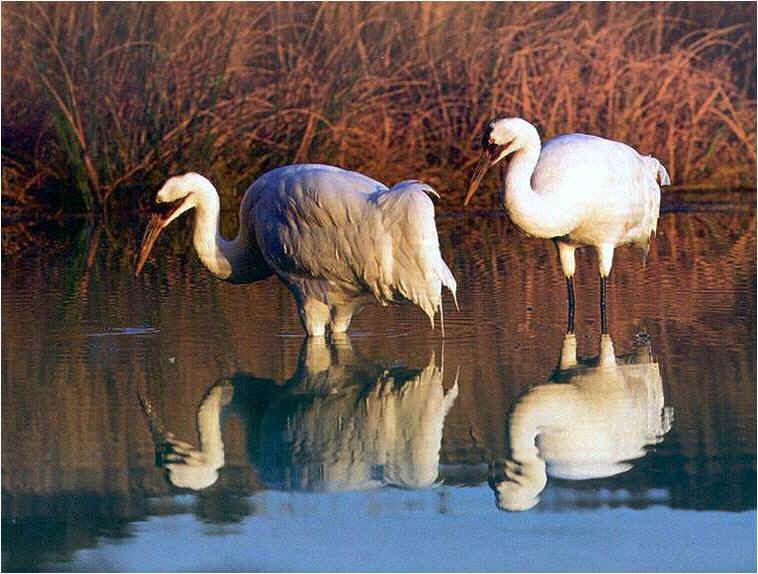
2 Whooping Cranes at the Redrock
National Wildlife Refuge in 1984,
photographed by Howard Eskin.
Howard, who was there for fishing, was not expecting
to find these birds. It was just he and the birds
(and hopefully a few fish) along the river.
![]()
SANDHILL CRANE
SANDHILL
CRANES were seen during the FONT tour in Texas in March 2014.
It was noted above that the Sandhill
Crane is the most common North American crane. Actually, it is also the most
numerous species of crane in the world.
There are 6 subspecies of the Sandhill Crane. One subspecies is
highly migratory, breeding as far north and west as eastern Siberia
and wintering as far south as Mexico.
Other subspecies are residents, in Florida and Georgia, in Mississippi,
and on the Isle de la Juventud, formerly called the Isle of Pines, in Cuba
in the Caribbean.
The 6 subspecies follow:
Grus
canadensis canadensis ______ (subspecies from Alaska
& Canada east to Baffin island; also west into Siberia, migrating south to
the southern US & northern Mexico)
Grus canadensis pratensis ______ (a resident
subspecies in Georgia & Florida)
Grus canadensis pulla ______ (a resident subspecies
in Mississippi) (subspecies described in 1972)
Grus canadensis rowani ______ (subspecies in Canada
from British Colombia to northern Ontario) (subspecies described in 1965)
Grus canadensis tabida ______ (subspecies in
southwestern Canada and the western & central US, migrating to the southern
US & north-central Mexico)
Grus canadensis nesiotes
______ (a resident subspecies in Cuba, on what has been called the Isle of Pines, now
called the Isle de la Juventud, the "Isle of Youth")
The Sandhill Crane was described by Linnaeus in 1758.
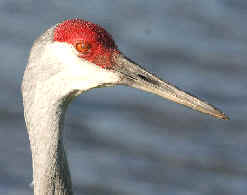
Above & below: Sandhill Cranes in Alaska,
of the nominate subspecies, Grus canadensis canadensis
(photos by Howard Eskin)
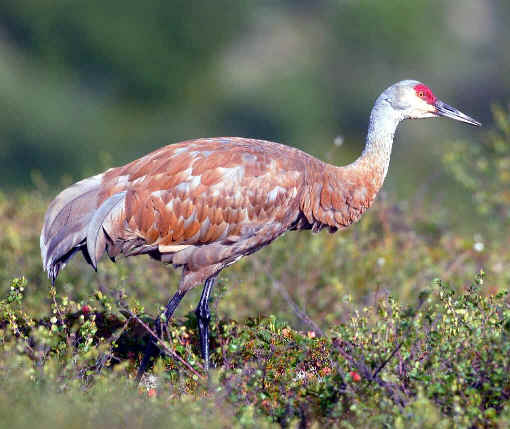
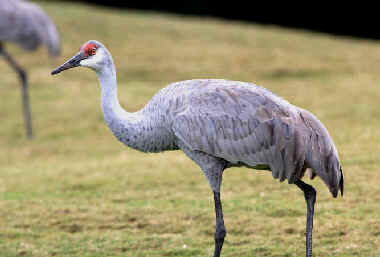
Above: A Sandhill Crane in
Florida
of the subspecies, Grus canadensis pratensis
(photo by Ed Kendell)
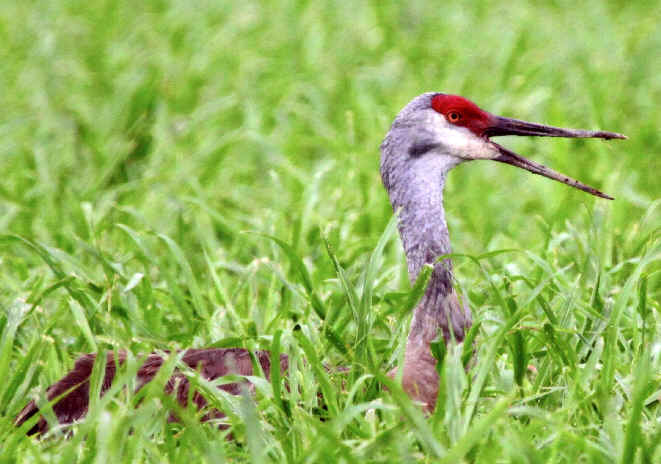
Generally, Sandhill Cranes
have been
most common in western North America,
but recently more have been occurring
in the northeastern part of the continent.
The above photo, a Sandhill Crane in Delaware
(photo by Marie Gardner)
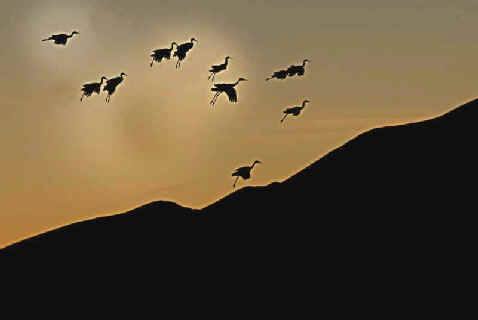
Sandhill
Cranes at dusk in Arizona
(photo by Monika Dorman)
An excellent book referring
to cranes, including those of Japan, is entitled "The Birds of Heaven -
Travels with Cranes" by Peter Matthiessen, with paintings and drawings by
Robert Bateman.
LINKS TO OTHER WEBSITES RELATING TO CRANES: